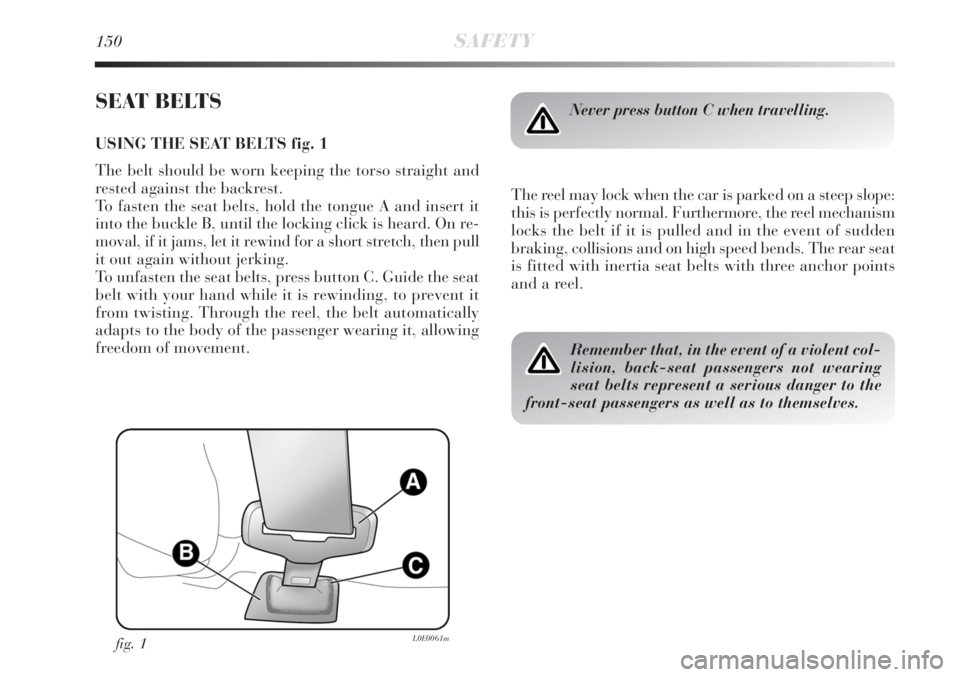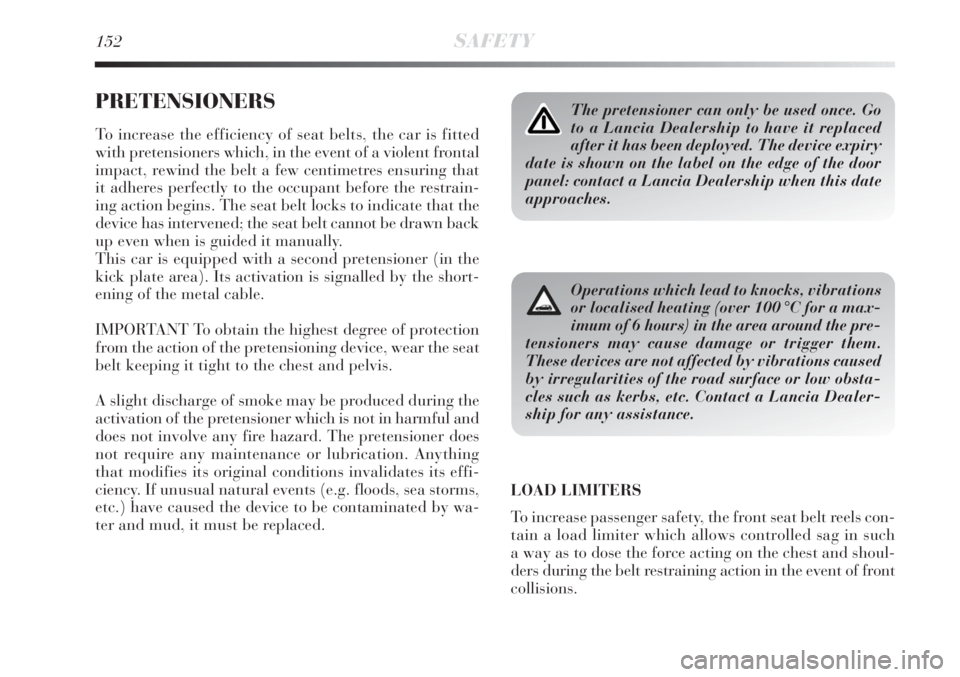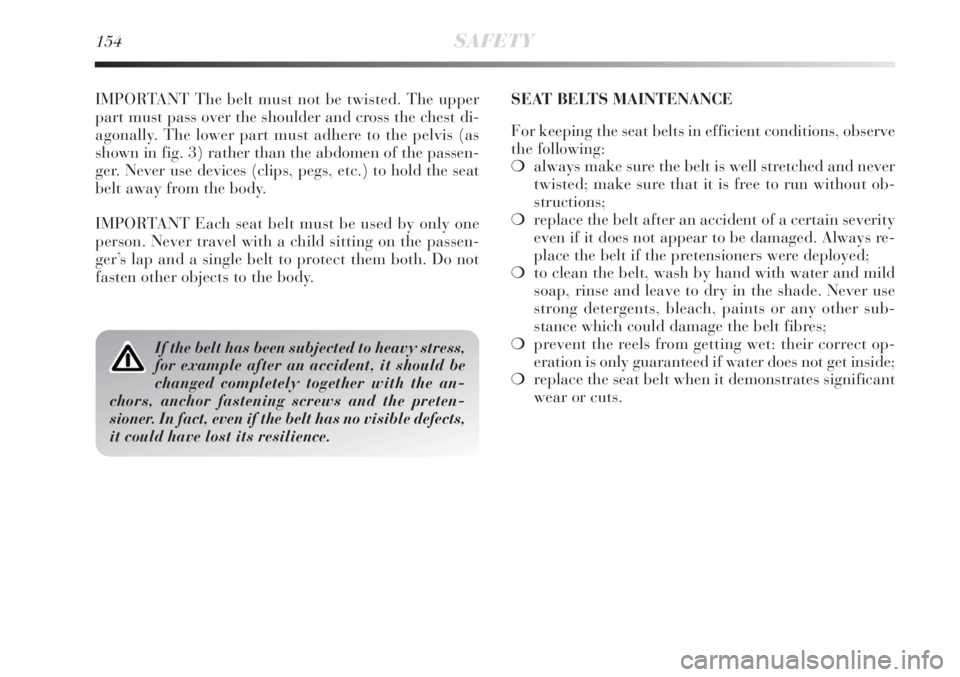Lancia Delta 2011 Owner handbook (in English)
Manufacturer: LANCIA, Model Year: 2011, Model line: Delta, Model: Lancia Delta 2011Pages: 290, PDF Size: 8.36 MB
Page 151 of 290

150SAFETY
SEAT BELTS
USING THE SEAT BELTS fig. 1
The belt should be worn keeping the torso straight and
rested against the backrest.
To fasten the seat belts, hold the tongue A and insert it
into the buckle B, until the locking click is heard. On re-
moval, if it jams, let it rewind for a short stretch, then pull
it out again without jerking.
To unfasten the seat belts, press button C. Guide the seat
belt with your hand while it is rewinding, to prevent it
from twisting. Through the reel, the belt automatically
adapts to the body of the passenger wearing it, allowing
freedom of movement.The reel may lock when the car is parked on a steep slope:
this is perfectly normal. Furthermore, the reel mechanism
locks the belt if it is pulled and in the event of sudden
braking, collisions and on high speed bends. The rear seat
is fitted with inertia seat belts with three anchor points
and a reel.
Never press button C when travelling.
Remember that, in the event of a violent col-
lision, back-seat passengers not wearing
seat belts represent a serious danger to the
front-seat passengers as well as to themselves.
fig. 1L0E0061m
Page 152 of 290

2
SAFETY151
The rear seat belts must be used as shown in the diagram
in fig. 2.
IMPORTANT After putting the seats back to their trav-
elling position, restore the seat belt position to make them
ready for use.
IMPORTANT If the rear seat is being moved and this
causes the middle seat belt to lock temporarily, normal
conditions can be restored by simply moving the seat to-
wards the back of the car.
fig. 2L0E0062m
S.B.R. SYSTEM
The car is provided with the S.B.R. (Seat Belt Reminder)
system, which warns the driver and the front passenger
if the seat belt is not fastened, as follows:
❍warning light
❍warning light
For permanent deactivation, contact a Lancia Dealer-
ship.
S.B.R. system can also be reactivated through the set-up
menu.
Page 153 of 290

152SAFETY
PRETENSIONERS
To increase the efficiency of seat belts, the car is fitted
with pretensioners which, in the event of a violent frontal
impact, rewind the belt a few centimetres ensuring that
it adheres perfectly to the occupant before the restrain-
ing action begins. The seat belt locks to indicate that the
device has intervened; the seat belt cannot be drawn back
up even when is guided it manually.
This car is equipped with a second pretensioner (in the
kick plate area). Its activation is signalled by the short-
ening of the metal cable.
IMPORTANT To obtain the highest degree of protection
from the action of the pretensioning device, wear the seat
belt keeping it tight to the chest and pelvis.
A slight discharge of smoke may be produced during the
activation of the pretensioner which is not in harmful and
does not involve any fire hazard. The pretensioner does
not require any maintenance or lubrication. Anything
that modifies its original conditions invalidates its effi-
ciency. If unusual natural events (e.g. floods, sea storms,
etc.) have caused the device to be contaminated by wa-
ter and mud, it must be replaced.
The pretensioner can only be used once. Go
to a Lancia Dealership to have it replaced
after it has been deployed. The device expiry
date is shown on the label on the edge of the door
panel: contact a Lancia Dealership when this date
approaches.
Operations which lead to knocks, vibrations
or localised heating (over 100 °C for a max-
imum of 6 hours) in the area around the pre-
tensioners may cause damage or trigger them.
These devices are not affected by vibrations caused
by irregularities of the road surface or low obsta-
cles such as kerbs, etc. Contact a Lancia Dealer-
ship for any assistance.
LOAD LIMITERS
To increase passenger safety, the front seat belt reels con-
tain a load limiter which allows controlled sag in such
a way as to dose the force acting on the chest and shoul-
ders during the belt restraining action in the event of front
collisions.
Page 154 of 290

2
SAFETY153
GENERAL INSTRUCTIONS FOR USING
THE SEAT BELTS
The driver must comply with (and have all car passengers
follow) any local regulations in force concerning the use
of seat belts. Always fasten the seat belts before starting.
Seat belts are also to be worn by expectant mothers: the
risk of injury in the case of accident is greatly reduced for
them and the unborn child if they are wearing a seat belt.
Pregnant women must position the lower part of the belt
very low down so that it passes over the pelvis and un-
der the abdomen (see fig. 3).
fig. 3L0E0063m
For maximum safety, keep the back of your
seat upright, lean back into it and make sure
the seat belt fits closely across your chest
and pelvis. Always fasten the seat belts on both the
front and the rear seats. Travelling without wear-
ing seat belts will increase the risk of serious in-
jury and even death in the event of an accident.
Under no circumstances should the components of
the seat belts and pretensioners be tampered with
or removed. Any operations must be carried out by
qualified and authorised personnel only. Always go
to a Lancia Dealership.
Page 155 of 290

154SAFETY
IMPORTANT The belt must not be twisted. The upper
part must pass over the shoulder and cross the chest di-
agonally. The lower part must adhere to the pelvis (as
shown in fig. 3) rather than the abdomen of the passen-
ger. Never use devices (clips, pegs, etc.) to hold the seat
belt away from the body.
IMPORTANT Each seat belt must be used by only one
person. Never travel with a child sitting on the passen-
ger’s lap and a single belt to protect them both. Do not
fasten other objects to the body.
If the belt has been subjected to heavy stress,
for example after an accident, it should be
changed completely together with the an-
chors, anchor fastening screws and the preten-
sioner. In fact, even if the belt has no visible defects,
it could have lost its resilience.
SEAT BELTS MAINTENANCE
For keeping the seat belts in efficient conditions, observe
the following:
❍always make sure the belt is well stretched and never
twisted; make sure that it is free to run without ob-
structions;
❍replace the belt after an accident of a certain severity
even if it does not appear to be damaged. Always re-
place the belt if the pretensioners were deployed;
❍to clean the belt, wash by hand with water and mild
soap, rinse and leave to dry in the shade. Never use
strong detergents, bleach, paints or any other sub-
stance which could damage the belt fibres;
❍prevent the reels from getting wet: their correct op-
eration is only guaranteed if water does not get inside;
❍replace the seat belt when it demonstrates significant
wear or cuts.
Page 156 of 290

2
SAFETY155
CARRYING CHILDREN SAFELY
For optimal protection in the event of a collision, all pas-
sengers must be seated and wearing adequate restraint
systems.
This is even more important for children.
This prescription is compulsory in all EC countries ac-
cording to EC Directive 2003/20/EC.
Compared with adults, a child’s head is proportionally
larger and heavier than the rest of the body, while mus-
cles and bone structure are not fully developed.
Therefore, correct restraint systems are necessary which
are different from adult seat belts.
The results of research on the best child restraint system
are contained in the European Standard ECE-R44, which
enforces the use of restraint systems classified into five
groups:
Group 0 0-10 kg in weight
Group 0+ 0-13 kg in weight
Group 1 9-18 kg in weight
Group 2 15-25 kg in weight
Group 3 22-36 kg in weight
DANGER: Do not put cradle seats facing
backwards on the front seat if the front pas-
senger airbag is enabled. Deployment of the
airbag in an accident could cause fatal in-
juries to the baby. It is advisable always to
carry children on the rear seat which is the most
protected position in the event of an accident. Never
fit child seats systems on the front seat if the car
is provided with passenger’s air bag: as the airbag
could even cause fatal injury regardless of the
severity of the collision which caused its deploy-
ment. If necessary, children can stay on the front
seat, but only if the passenger’s airbag can be dis-
abled. In this case be sure to verify that the air bag
is actually deactivated, observing the “warning
light on the dashboard (see “Front air bag – pas-
senger side” in paragraph “Front air bags”). Move
the passenger’s seat as far back as possible to avoid
contact between the child seat and the dashboard.
Page 157 of 290

156SAFETY
All child restraint devices must bear the certification data,
together with the control mark, on a label solidly fixed to
the seat which must never be removed.
Over 1.50 m in height, from the point of view of restraint
systems, children are considered as adults and wear the
seat belts normally. Lineaccessori Lancia includes child
seats for each weight group.
These devices are recommended and have been specifi-
cally designed for Lancia cars.
GROUP 0 and 0+
Babies up to 13 kg must be carried facing backwards on
a cradle seat, which, supporting the head, does not induce
stress on the neck in the event of sharp decelerations.
The cradle is restrained by the car seat belts, as shown
in fig. 4 and, in turn, it must restrain the child with its
own belts.
GROUP 1
From 9 kg to 18 kg of weight, children may be carried
facing forwards.
fig. 4L0E0272m
Page 158 of 290

2
SAFETY157
GROUP 2
Children from 15 to 25 kg may use the car seat belts di-
rectly fig. 4.
The child seat is needed only to position the child cor-
rectly with respect to the belts so that the diagonal sec-
tion crosses the child’s chest and never the neck, and the
lower part is snug on the pelvis not the abdomen.
GROUP 3
For children from 22 kg up to 36 kg suitable risers make
fastening the seat belt easier.
Figure 4 shows correct child seat positioning on the rear
seat. Children over 1.50 m in height can wear seat belts
like adults.Below is a summary of the safety rules to be followed
when carrying children:
1) The recommended position for installing child seats
is on the rear seat, as it is the most protected area in
the event of a crash.
2) If the passenger air bag is deactivated always check
that the warning light “is lit on the instrument panel
to make sure that it has actually been deactivated.
3) Carefully follow the instructions supplied with the
child restraint system which the manufacturer must
provide. Keep the instructions in the car along with
the other documents and this handbook. Do not use
second-hand child seats without instructions.
4) Always check the seat belt is well fastened by pulling
the strap.
5) Only one child is to be strapped into each retaining
system; never carry two children using one child seat.
6) Always check that the seat belts do not rest on the
child’s neck.
7) While travelling, do not let the child sit incorrectly or
release the belts.
8) Never carry children on your lap, even newborns. No-
one, however strong, can restrain a child in the event
of an accident.
9) In the event of an accident, replace the child’s seat
with a new one.
The figures are only examples for fitting
purposes. To install the child restraint, re-
fer to the instructions supplied with the
same. Child seats with Isofix attachments are
available for a safe anchoring to the seat without
using the car seat belts.
Page 159 of 290

158SAFETY
SUITABILITY OF PASSENGER SEATS FOR CHILD SEAT USE
The car complies with the new European Directive 2000/3/EC which governs the arrangement possibilities for child
seats on the various seats of the car as shown in the following table:
Key:
U = suitable for child restraint systems of the “Universal” category, according to European Standard EEC-R44 for the specified
“Groups”.
X = no child seats may be fitted in the middle rear seat.
(*) The rear seat backrest must be in the vertical position.
Front Rear side Rear central
Group Weight groups passenger passenger passenger
Groups 0, 0+ up to 13 kg U U (*) X
Group 1 9-18 kg U U (*) X
Group 2 15-25 kg U U (*) X
Group 3 22-36 kg U U (*) X
Versions with fixed rear seat excluded
Page 160 of 290

2
SAFETY159
Versions with fixed rear seat only
Key:
U = suitable for child restraint systems of the “Universal” category, according to European Standard EEC-R44 for the specified
Groups”.
X = no child seats may be fitted in the rear side seat (driver side).
Group Weight groups Front passenger Passenger Rear central Rear side
(passenger side) passenger passenger
(driver side)
Groups 0, 0+ up to 13 kg U U U X
Group 1 9-18 kg U U U X
Group 2 15-25 kg U U U X
Group 3 22-36 kg U U U X